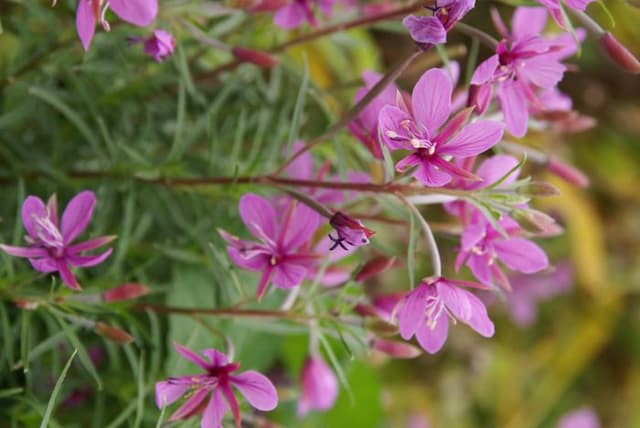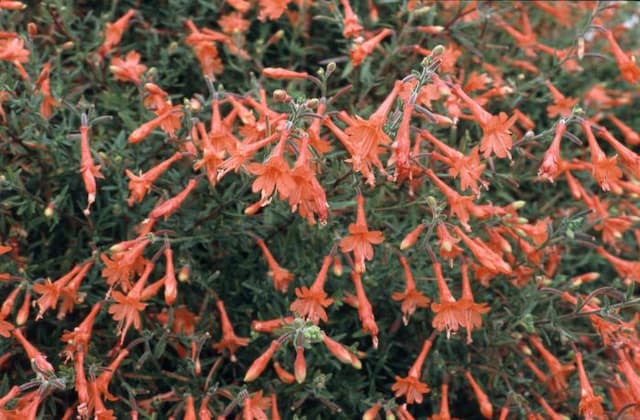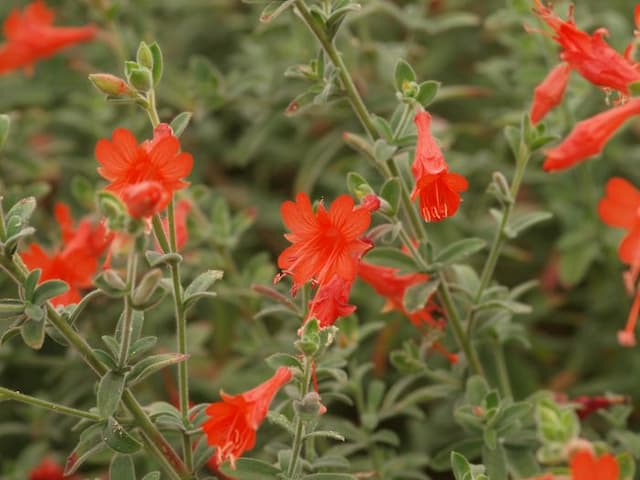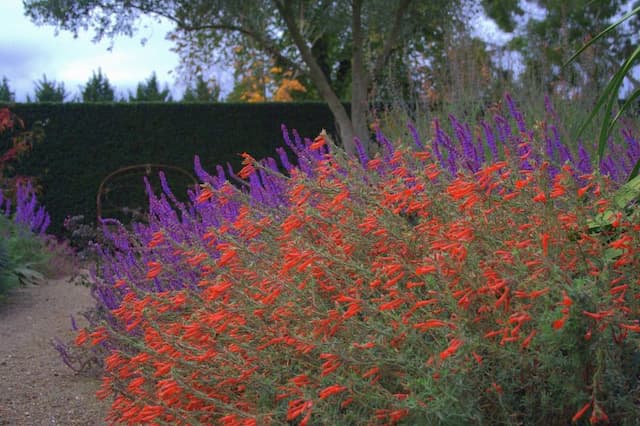Fuchsia Fuchsia 'Thalia' (T)

ABOUT
Fuchsia 'Thalia' showcases a particularly stunning display with its exquisite flowers and foliage. The plant is adorned with elegant, hanging flowers that are a remarkable attraction. These flowers are characterized by their unique two-tone coloration, featuring a bold combination of purples and pinks. The blossoms have a teardrop shape, with a long, tubular structure that flares out into beautiful, flowing sepals at the top. The petals curl gracefully inwards, presenting a delicate appearance. Complementing the vivid blooms, the foliage of the Fuchsia 'Thalia' adds to its ornamental charm. The leaves are typically a rich, deep green, and they are arranged along the stems in a way that provides a lush backdrop for the flowers. Infused with a touch of artistry, the leaves occasionally exhibit subtle variegation or margins tinged in a paler shade, which beautifully frames the foliage. A characteristic of this plant is its growth habit which contributes to its overall grace. The stems are somewhat trailing and, when supported, can cascade elegantly, making this plant ideal for hanging baskets or elevated containers where its true beauty can be displayed to full effect. The branches and stems bear the flowers and leaves in an attractive pattern that gives Fuchsia 'Thalia' an illusion of being constantly in motion, especially as the flowers dance lightly in the breeze. In summary, Fuchsia 'Thalia' is a feast for the eyes, with its striking flowers and lovely green foliage. It embodies a harmonious blend of vibrant colors and delicate form, making it a popular choice for gardeners looking to add a touch of sophistication and elegance to their plant displays.
About this plant
 Names
NamesFamily
Onagraceae
Synonyms
Hardy Fuchsia, Lady's Eardrops, Thalia Fuchsia
Common names
Fuchsia 'Thalia'
 Toxicity
ToxicityTo humans
Fuchsia, including the 'Thalia' variety, is generally considered non-toxic to humans. However, if a person ingests a significant amount of the plant, mild gastrointestinal discomfort may occur. It's important to note that the berries of some fuchsia species can be edible, but it is always best to err on the side of caution and not consume any plant parts unless you are certain of their safety and edibility.
To pets
Fuchsia, including the 'Thalia' variety, is generally considered non-toxic to pets as well. Ingestion of the plant may occasionally cause mild digestive upset in some animals, but it is not known to cause serious harm or toxicity. As with any non-food plant, it's advisable to prevent your pets from eating fuchsias to avoid any potential stomach discomfort.
 Characteristics
CharacteristicsLife cycle
Perennials
Foliage type
Deciduous
Color of leaves
Green
Flower color
Red
Height
4-5 feet (1.2-1.5 meters)
Spread
2 feet (0.6 meters)
Plant type
Shrub
Hardiness zones
9
Native area
Central America
Benefits
 General Benefits
General Benefits- Vibrant Aesthetics: Fuchsia 'Thalia' adds a pop of color to gardens with its striking red and purple flowers.
- Attracts Pollinators: The bright flowers are known to attract hummingbirds and butterflies, promoting pollination in the garden.
- Versatility in Landscaping: Can be used in hanging baskets, container gardens, or as border plants, providing flexibility in design.
- Extended Blooming: Often blooms from spring to fall, offering a long season of visual interest.
- Shade Tolerance: Unlike many flowering plants, it can thrive in partial shade conditions.
- Cooling Effect: The foliage and flowers can provide a cooling effect in the garden, making nearby spaces feel more comfortable in the heat.
- Enhances Garden Texture: The unique shape of its flowers and foliage adds visual texture and contrast to garden designs.
 Medical Properties
Medical PropertiesThis plant is not used for medical purposes.
 Air-purifying Qualities
Air-purifying QualitiesThis plant is not specifically known for air purifying qualities.
 Other Uses
Other Uses- Fuchsia 'Thalia' can be used in creating natural dyes for fabrics, giving a range of pink to purple hues depending on the mordant used.
- The blossoms of Fuchsia can inspire artwork and photography due to their unique shape and vivid colors, making them a subject for artists and photographers.
- Fuchsia flowers can be used as edible decorations for cakes and desserts, adding a splash of color and a slight tart flavor.
- Dried Fuchsia flowers can serve as a component in potpourri blends, contributing a decorative element to the mix.
- The plant can play a role in educational settings, such as schools or botanical gardens, to teach about pollination and the growth cycle of flowering plants.
- Fuchsias can be included in floral arrangements for events and functions, where their drooping blooms add elegance and a touch of whimsy to table settings.
- Their rich colors and unique form can be a source of inspiration for fashion designers, influencing patterns and motifs in textile designs.
- Fuchsia plants can be used as indicators of a healthy garden ecosystem, as they attract pollinators like hummingbirds and bees.
- When grown in container gardens, Fuchsia 'Thalia' can be arranged to create living sculptures or topiaries as a form of creative gardening.
- The petals of Fuchsia 'Thalia' can be used in crafting, such as in making eco-friendly confetti for celebrations or pressed flower crafts.
Interesting Facts
 Feng Shui
Feng ShuiThe Fuchsia is not used in Feng Shui practice.
 Zodiac Sign Compitability
Zodiac Sign CompitabilityThe Fuchsia is not used in astrology practice.
 Plant Symbolism
Plant Symbolism- Confiding Love: Fuchsia, with its hanging blossoms, has often been seen as a symbol of confiding love. The graceful droop of the flowers might be interpreted as a gentle bow of the head, suggesting trust and intimacy.
- Tastefulness: The elegant design and the unique color combination of the Fuchsia Thalia’s flowers are associated with tastefulness and good judgment in aesthetics, reflecting a sense of refinement and sophistication.
- Ardent Affection: The vibrant colors and the abundance of flowers that Fuchsia plants typically produce can symbolize an ardent, deep affection that is full of energy and life.
- Warning: Interestingly, in some Victorian language of flowers, Fuchsia could be a warning, possibly due to its somewhat exotic and striking appearance that could signal caution.
 Water
WaterThe Lady's Eardrops should be watered when the top inch of soil feels dry to the touch, typically about once a week. However, during hot weather or when the plant is in full sun, it may require more frequent watering, possibly every few days. Be sure to provide enough water to soak the soil thoroughly, which would generally be about 2 gallons for a standard potted plant. During the winter months, reduce watering to every other week, ensuring the soil remains moist but not waterlogged.
 Light
LightLady's Eardrops thrive in bright, indirect light, and they perform best when they are placed in a spot that receives morning sunlight and afternoon shade. An ideal position would be eastern exposure with some dappled sunlight. Avoid exposing the fuchsia to the harsh midday sun, which can burn its leaves and flowers.
 Temperature
TemperatureLady's Eardrops prefer cooler temperatures and do best when the temperature ranges between 55 and 75 degrees Fahrenheit. While they can survive temperatures as low as 40 degrees Fahrenheit for short periods, they should be protected from frost. The ideal temperature range for flourishing growth and blooms is 60 to 70 degrees Fahrenheit.
 Pruning
PruningPruning Lady's Eardrops encourages bushier growth and more blooms. Prune the plant in late winter or early spring before new growth begins. Remove dead or weak stems and cut back about one-third of the plant to promote a fuller shape. Pruning can be done every year to maintain the plant's health and appearance.
 Cleaning
CleaningAs needed
 Soil
SoilFuchsia requires a well-draining potting mix with a slight acid to neutral pH, typically between 6.0 and 7.0. A good soil recipe could include one part peat moss, one part loam, and one part perlite or sand to aid in drainage.
 Repotting
RepottingFuchsias should be repotted annually or biennially when they have outgrown their current container or when the soil has become compacted. Spring is the best time for repotting Fuchsias before the onset of new growth.
 Humidity & Misting
Humidity & MistingFuchsia plants thrive in high humidity conditions, ideally between 60-70%. Providing a tray of pebbles and water beneath the plant can help maintain a humid microclimate around the foliage.
 Suitable locations
Suitable locationsIndoor
Provide indirect light, cool temps, and high humidity for indoor Fuchsias.
Outdoor
Place Fuchsias in dappled shade and shelter from strong winds outside.
Hardiness zone
9-11 USDA
 Life cycle
Life cycleThe life cycle of the Fuchsia 'Thalia', commonly known as Fuchsia, begins with seed germination when environmental conditions are favorable; this typically involves warm temperatures and moist soil. Seedlings emerge and grow into young plants, with the distinctive fuchsia foliage, and then develop into flowering plants. Fuchsia 'Thalia' typically flowers from late spring to early autumn, producing pendant, tubular flowers that are attractive to hummingbirds and other pollinators. After pollination, the flowers develop into small fruit bearing seeds, completing the reproductive cycle. During winter or in response to adverse conditions, the plant may become dormant, losing leaves and ceasing growth temporarily. With the return of favorable conditions, such as the warmth and lengthening daylight of spring, the plant will resume growth, starting a new cycle.
 Propogation
PropogationPropogation time
Spring-Early Summer
The most popular method of propagating Fuchsia 'Thalia', commonly known as hardy fuchsia, is through softwood cuttings. This is best done in late spring to early summer when new growth is soft and pliable. To propagate, a healthy stem tip about 2 to 4 inches (5 to 10 centimeters) long is cut just below a leaf node. The lower leaves are then removed, and the cutting may be dipped in a rooting hormone to encourage root development. The cutting is then planted in a moist potting mix and covered with plastic to maintain humidity. It’s important to keep the soil consistently moist but not waterlogged and to place the cutting in a warm area with indirect sunlight. Roots typically develop within 3 to 4 weeks, after which the new plant can be gradually acclimated to less humid conditions and eventually transplanted outside.









